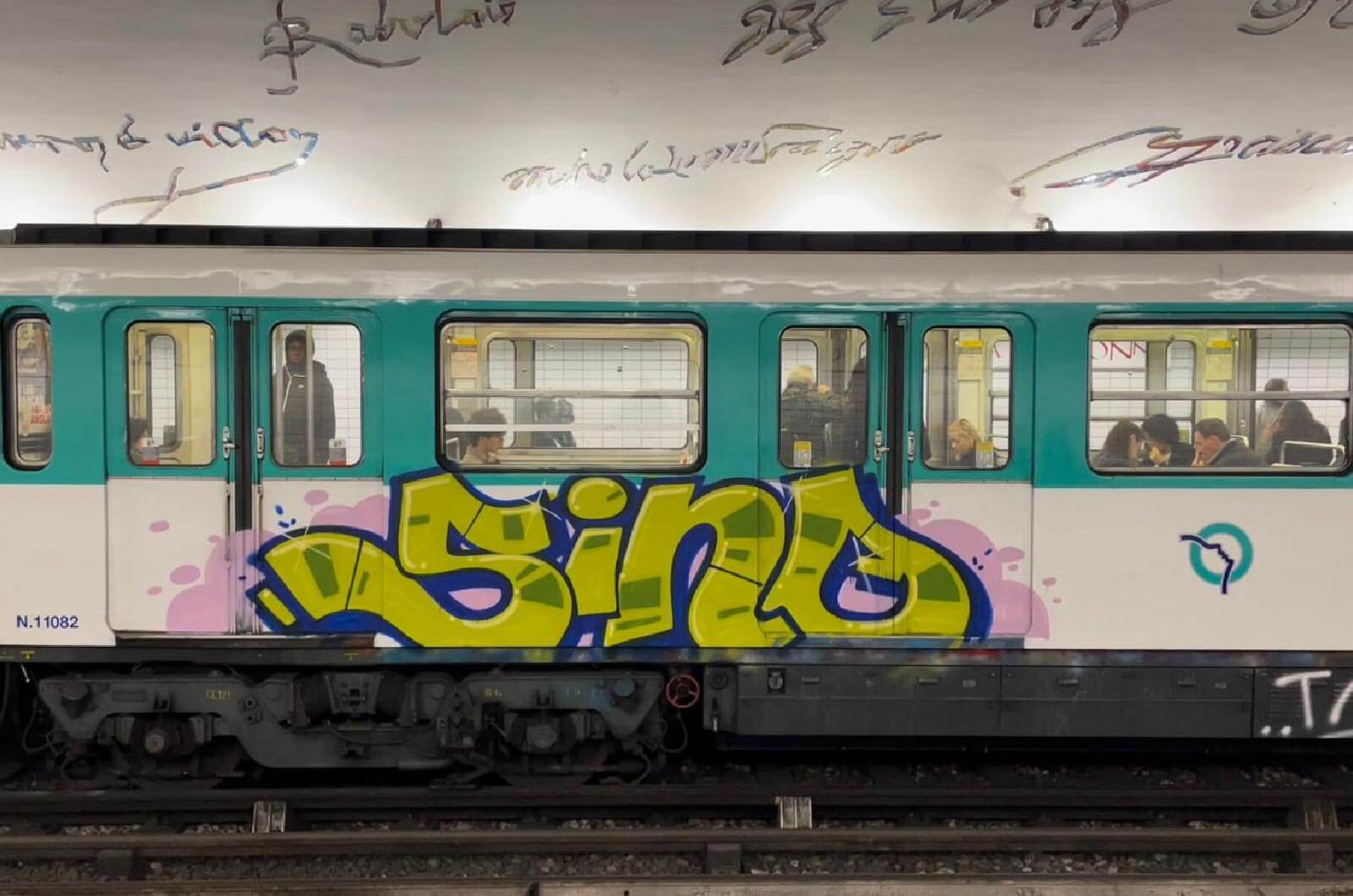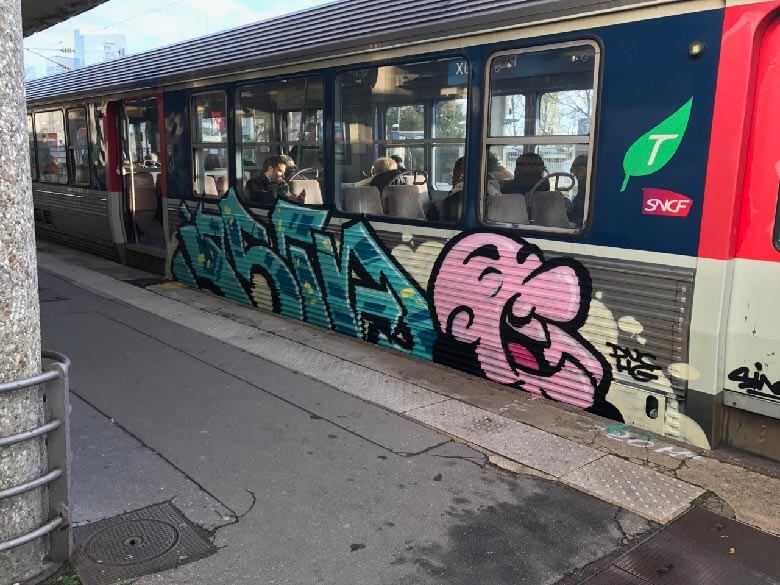
Montana Gallery Barcelona welcomes the work of Sino. The veteran French graffiti writer has dedicated studio time to researching the most stark aesthetics of street graffiti and its interaction with the walls of the city. Tags, strokes and scratches are superimposed on different textures that seem to have been plucked from an alley.
What does “old school” mean? This label, which was originally used to refer to graffiti before the 90’s, is used nowadays to designate veteran writers that have a classic style or even those who painted a long time ago and stopped. This classification would be more than applicable to Sino only in its original meaning and, as we will see, its beginnings in graffiti date back to more than 35 years ago.
Sino has become a key player in Canadian graffiti thanks, among other things, to his point of sale Le Sino, aka Montana Shop Montreal. With his return to the French capital, his adventures in graffiti no longer compromise his project and the DUC member has returned to street activity with the energy of a teenager. So we took advantage of his exhibition at the Montana Gallery to talk not only about exhibitions and paintings, but also about streets, roads and tunnels.


Can you tell us about your trajectory as a graffiti writer and artist?
I started painting graffiti in 1987 in Paris but it was in ‘88 that I officially chose the name Sino.
Mostly, at first, I was painting close to where I lived, the Saint-Lazarre metro line. At the end of 1990, I started painting trains, but I always preferred street graffiti over trains, because I liked the fact that I could see it.
In ‘98, I moved to Montreal, Canada. That is where I met Matis, my main partner at the time over there. We did a lot of street spots in a city where the buff was intense.
“At first, the shop was just a way to pay for my own paint, a bit like a small drug dealer who sells to get his own consumption for free, but the shop grew quickly.”
A bit later, I opened a graffiti shop and I kind of had to slack bombing because it would have been too easy for local authorities to identify me. At first, the shop was just a way to pay for my own paint, a bit like a small drug dealer who sells to get his own consumption for free, but the shop grew quickly. It was exactly at this moment that Montreal’s graffiti scene was in full expansion. In the mid 2000’s I became Montana Colors’ Canadian distributor and ‘Le Sino is still Montreal’s official Montana Shop.
In the 2010’s, I started coming back to Paris more and more because my family lives here. Nowadays, besides graffiti, I share a studio space with Zenoy and paint canvases, a practice that I started about 10 years ago. I think it’s very exciting to start in the art world what I already accomplished in the graff game: making a name for myself. And now I’m here for my exhibition at Montana Gallery Barcelona!



We’ve noticed that you’ve been more active lately in Paris. Is there any specific reason?
No, not really. In fact, every time I would come back to Paris, I would paint spots when I’d see one. And now that I’m officially back, it is still like that. Maybe you think that because they recently cleaned the peripheral highway and that I painted a lot of visible spots on with my homies. I also painted the Metro recently, even though it’s not my favorite. But they invited me, so why not!? It’s still always fun to paint some clean trains.



What do you look for when you paint graffiti versus when you make art? Is there a difference between these two practices?
It is completely different. There is a culture behind graffiti; codes and rules to follow. Yes, you can push or change these rules, like many kids do now, but there are still rules to follow: the 2023 codes. Ok, nowadays it is true that these rules are more open, but I still represent the way we saw things back then. For me, graffiti means putting up your personal publicity, to have fun with the homies, to paint an illegal spot in 15 minutes. Back then, I would also almost never take pictures of my pieces.
“I think that graffiti in the studio doesn’t make sense, even though I can’t totally step away from it”
Conversely, in the studio, I try to get rid of the graffiti culture to do whatever I want technically. For me, it’s a new horizon. Most of the time, my paintings take about a week to get done and sometimes I just let them sit for a while when I don’t know how to finish them. The whole process is really different from graffiti and I think that graffiti in the studio doesn’t make sense, even though I can’t totally step away from it.
Also, I don’t have any specific plan when I start a painting; it grows organically. But when it comes to graffiti, however, I always have a plan. For example, I went on a metro mission recently and when we finished, the guy I was with wanted to paint another one. I had nothing prepared, no other plan, so I didn’t paint. No worries, I still stayed there!



Indeed, we feel a huge graffiti influence in your studio practice. It looks like a romantic version of graffiti since it recalls tags, throws or pieces erased by time. And those wall textures…
What you see now is something that I’ve wanted to do for about 10 years, but it felt like I couldn’t do it. First, for technical reasons and second, because I thought that people would think it was too filthy. At the time, graff writers that would do art would make super clean stuff, similar to graffiti, so I went in that direction naturally. In the end, that’s not really what I wanted to do…
I think my paintings are a representation of walls. If you look at a wall, the wall is standing, living, functioning as a wall. You too, are alive, there, watching it. What you see on this wall are traces of life, of time passing, of wrinkles or wounds that you may have, memories that fade away, of people that you lost. I think that is what I see in my paintings.
“When I paint graffiti, I put nice colors in ‘’ugly’’ places. With my studio work, I bring these ugly places indors and make them look good.”
They’re also little parts of the ghetto; grimy streets taken out of their context. When I paint graffiti, I put nice colors in ‘’ugly’’ places. With my studio work, I bring these ugly places indoors and make them look good. This dirty part of the wall will become nice, as graffiti does when it’s done in grimy locations.
I understand that some people don’t fancy this new approach and that they prefer the ‘’older’’ Sino. I put myself in ‘’danger’’ doing something new with my art. I didn’t know if people would accept it or not. I must admit that I am still struggling a bit with all that.

2 What do you think?
Add a comment